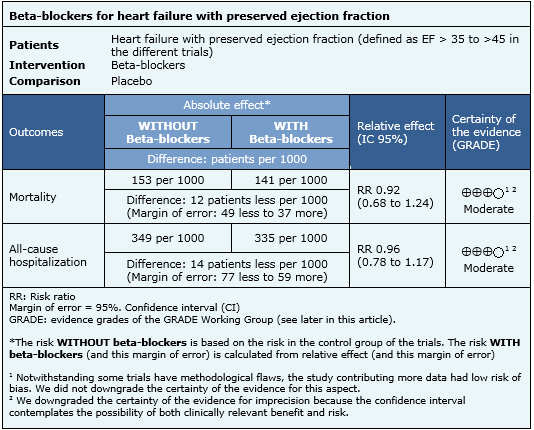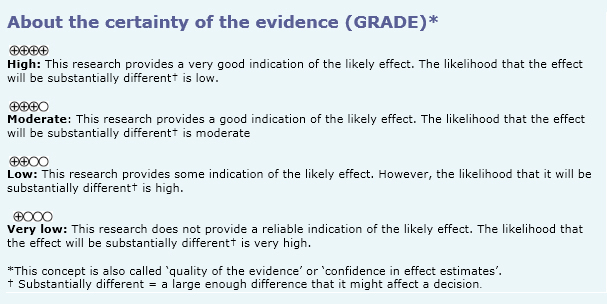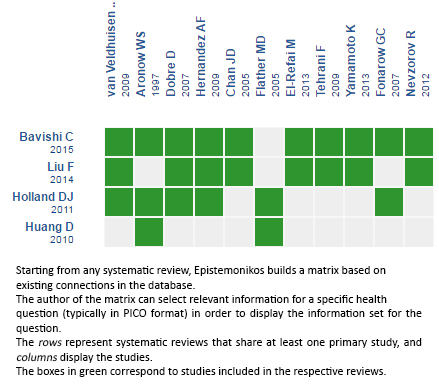Resúmenes Epistemonikos
← vista completaPublicado el 2 de noviembre de 2016 | http://doi.org/10.5867/medwave.2016.6593
¿Son efectivos los betabloqueadores en la insuficiencia cardiaca con fracción de eyección preservada?
Are beta-blockers effective in heart failure with preserved ejection fraction?
Abstract
Beta-blockers constitute standard therapy for heart failure with reduced ejection. However, their role in patients with preserved ejection fraction is not clear. Searching in Epistemonikos database, which is maintained by screening multiple databases, we identified four systematic reviews covering 19 primary studies, including seven randomized trials answering the question of this summary. We combined the evidence using meta-analysis and generated a summary of findings table following the GRADE approach. We concluded the use of beta-blockers probably leads to little or no difference in the risk of death or hospitalization in patients with heart failure with preserved ejection fraction.
Problem
Around 50% of patients with heart failure have preserved ejection fraction, with or without diastolic dysfunction, and there is no treatment that is clearly effective.
Beta-blockers constitute standard therapy for heart failure with reduced ejection fraction. As they reduce heart rate it has been postulated they can also improve diastolic function, so constituting an alternative for patients with preserved ejection fraction. However, their clinical role is not clear.
Methods
We used Epistemonikos database, which is maintained by screening more than 30 databases, to identify systematic reviews and their included primary studies. With this information we generated a structured summary using a pre-established format, which includes key messages, a summary of the body of evidence (presented as an evidence matrix in Epistemonikos), meta-analysis of the total of studies, a summary of findings table following the GRADE approach and a table of other considerations for decision-making.
|
Key messages
|
About the body of evidence for this question
|
What is the evidence. |
We found four systematic reviews [1],[2],[3],[4] including 19 primary studies, reported in 20 references [5],[6],[7], [8],[9],[10],[11],[12],[13],[14],[15],[16],[17],[18],[19],[20], |
|
What types of patients were included |
Ejection fraction was defined as >35% in one trial [9], > 40% in one trial [8] and > 45% in one trial [10]. Mean ejection fraction in the trials ranged from 49% to 63%. Even though trials did not restrict inclusion by functional class, most patients were NYHA II or III. All of the trials included adults. SENIORS trial restricted inclusion to patients over 70 years [9]. Mean age ranged from 66 to 76 years across studies. Between 66 and 86% of patients were hypertensive in the different trials, 3 to 24% had diabetes and 37 to 41% had atrial fibrillation. The latter were excluded in SWEDIC trial [10]. Etiology was ischemic in 77% of patients in SENIORS [9], 15% in J-DHF [8] and it was not reported in SWEDIC [10]. |
|
What types of interventions were included |
Two trials used carvedilol [8],[10] and one nebivolol [9]. In one trial carvedilol was initiated at 2.5 mg per day, then increasing up to 20 mg per day [8]; in the other trial initial dose was not reported, but the target dose was 25 or 50 mg depending on body weight [10]. Nebivolol starting dose was 1.25 mg per day, increasing up to 10 mg per day [9]. All of the trials compared against placebo. |
|
What types of outcomes |
The different systematic reviews identified groups outcomes as follows:
|
Summary of findings
The information on the effects of beta-blockers for heart failure with preserved ejection fraction is based on three randomized trials including 1094 participants. All of the trials reported mortality, but one did not have any event [10]. Only one trial reported all-cause hospitalization [9]. The summary of findings is the following:
- Use of beta-blockers probably leads to little or no difference in the risk of death in patients with heart failure with preserved ejection fraction. The certainty of the evidence is moderate.
- Use of beta-blockers probably leads to little or no difference in the risk of hospitalization in patients with heart failure with preserved ejection fraction. The certainty of the evidence is moderate.


Other considerations for decision-making
|
To whom this evidence does and does not apply |
|
| About the outcomes included in this summary |
|
| Balance between benefits and risks, and certainty of the evidence |
|
| What would patients and their doctors think about this intervention |
|
| Resource considerations |
|
|
Differences between this summary and other sources |
|
| Could this evidence change in the future? |
|
How we conducted this summary
Using automated and collaborative means, we compiled all the relevant evidence for the question of interest and we present it as a matrix of evidence.

Follow the link to access the interactive version: Beta-blockers for heart failure with preserved ejection fraction.
Notes
The upper portion of the matrix of evidence will display a warning of “new evidence” if new systematic reviews are published after the publication of this summary. Even though the project considers the periodical update of these summaries, users are invited to comment in Medwave or to contact the authors through email if they find new evidence and the summary should be updated earlier. After creating an account in Epistemonikos, users will be able to save the matrixes and to receive automated notifications any time new evidence potentially relevant for the question appears.
The details about the methods used to produce these summaries are described here http://dx.doi.org/10.5867/medwave.2014.06.5997.
Epistemonikos foundation is a non-for-profit organization aiming to bring information closer to health decision-makers with technology. Its main development is Epistemonikos database (www.epistemonikos.org).
These summaries follow a rigorous process of internal peer review.
Conflicts of interest
The authors do not have relevant interests to declare.

